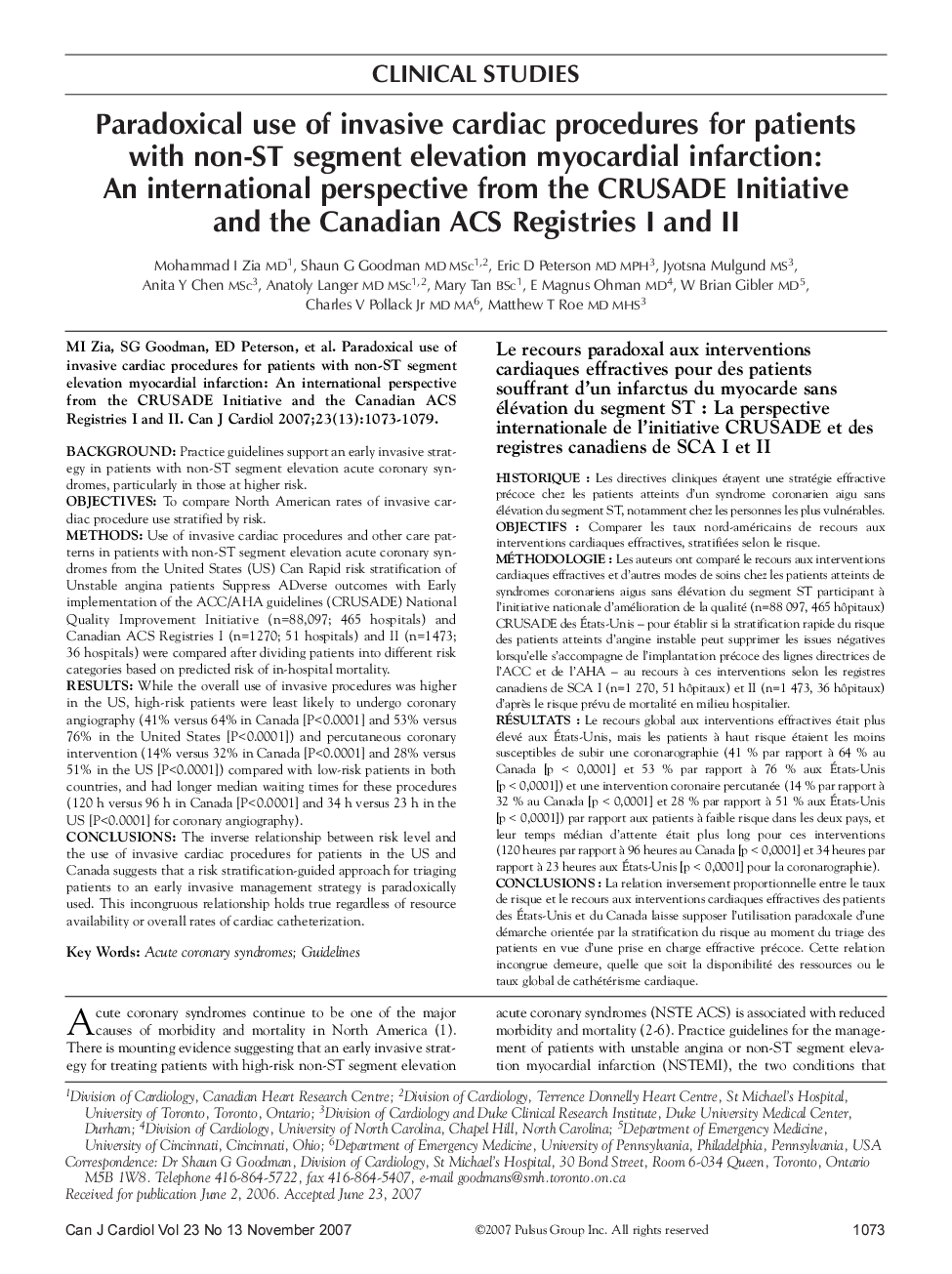| کد مقاله | کد نشریه | سال انتشار | مقاله انگلیسی | نسخه تمام متن |
|---|---|---|---|---|
| 2728128 | 1566594 | 2007 | 7 صفحه PDF | دانلود رایگان |

BackgroundPractice guidelines support an early invasive strategy in patients with non-ST segment elevation acute coronary syndromes, particularly in those at higher risk.ObjectivesTo compare North American rates of invasive cardiac procedure use stratified by risk.MethodsUse of invasive cardiac procedures and other care patterns in patients with non-ST segment elevation acute coronary syndromes from the United States (US) Can Rapid risk stratification of Unstable angina patients Suppress ADverse outcomes with Early implementation of the ACC/AHA guidelines (CRUSADE) National Quality Improvement Initiative (n = 88,097; 465 hospitals) and Canadian ACS Registries I (n = 1270; 51 hospitals) and II (n = 1473; 36 hospitals) were compared after dividing patients into different risk categories based on predicted risk of in-hospital mortality.ResultsWhile the overall use of invasive procedures was higher in the US, high-risk patients were least likely to undergo coronary angiography (41% versus 64% in Canada [P<0.0001] and 53% versus 76% in the United States [P < 0.0001]) and percutaneous coronary intervention (14% versus 32% in Canada [P < 0.0001] and 28% versus 51% in the US [P < 0.0001]) compared with low-risk patients in both countries, and had longer median waiting times for these procedures (120 h versus 96 h in Canada [P < 0.0001] and 34 h versus 23 h in the US [P < 0.0001] for coronary angiography).ConclusionsThe inverse relationship between risk level and the use of invasive cardiac procedures for patients in the US and Canada suggests that a risk stratification-guided approach for triaging patients to an early invasive management strategy is paradoxically used. This incongruous relationship holds true regardless of resource availability or overall rates of cardiac catheterization.
HistoriqueLes directives cliniques étayent une stratégie effractive précoce chez les patients atteints d’un syndrome coronarien aigu sans élévation du segment ST, notamment chez les personnes les plus vulnérables.ObjectifsComparer les taux nord-américains de recours aux interventions cardiaques effractives, stratifiées selon le risque.MéthodologieLes auteurs ont comparé le recours aux interventions cardiaques effractives et d’autres modes de soins chez les patients atteints de syndromes coronariens aigus sans élévation du segment ST participant à l’initiative nationale d’amélioration de la qualité (n = 88 097, 465 hôpitaux) CRUSADE des États-Unis – pour établir si la stratification rapide du risque des patients atteints d’angine instable peut supprimer les issues négatives lorsqu’elle s’accompagne de l’implantation précoce des lignes directrices de l’ACC et de l’AHA – au recours à ces interventions selon les registres canadiens de SCA I (n = 1 270, 51 hôpitaux) et II (n = 1 473, 36 hôpitaux) d’après le risque prévu de mortalité en milieu hospitalier.RésultatsLe recours global aux interventions effractives était plus élevé aux États-Unis, mais les patients à haut risque étaient les moins susceptibles de subir une coronarographie (41% par rapport à 64% au Canada [p < 0,0001] et 53% par rapport à 76% aux États-Unis [p < 0,0001]) et une intervention coronaire percutanée (14% par rapport à 32% au Canada [p < 0,0001] et 28% par rapport à 51% aux États-Unis [p < 0,0001]) par rapport aux patients à faible risque dans les deux pays, et leur temps médian d’attente était plus long pour ces interventions (120 heures par rapport à 96 heures au Canada [p < 0,0001] et 34 heures par rapport à 23 heures aux États-Unis [p < 0,0001] pour la coronarographie).ConclusionsLa relation inversement proportionnelle entre le taux de risque et le recours aux interventions cardiaques effractives des patients des États-Unis et du Canada laisse supposer l’utilisation paradoxale d’une démarche orientée par la stratification du risque au moment du triage des patients en vue d’une prise en charge effractive précoce. Cette relation incongrue demeure, quelle que soit la disponibilité des ressources ou le taux global de cathétérisme cardiaque.
Journal: Canadian Journal of Cardiology - Volume 23, Issue 13, November 2007, Pages 1073-1079